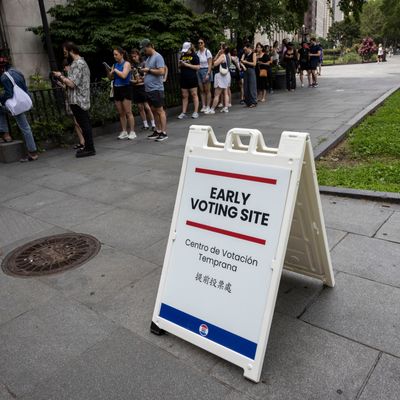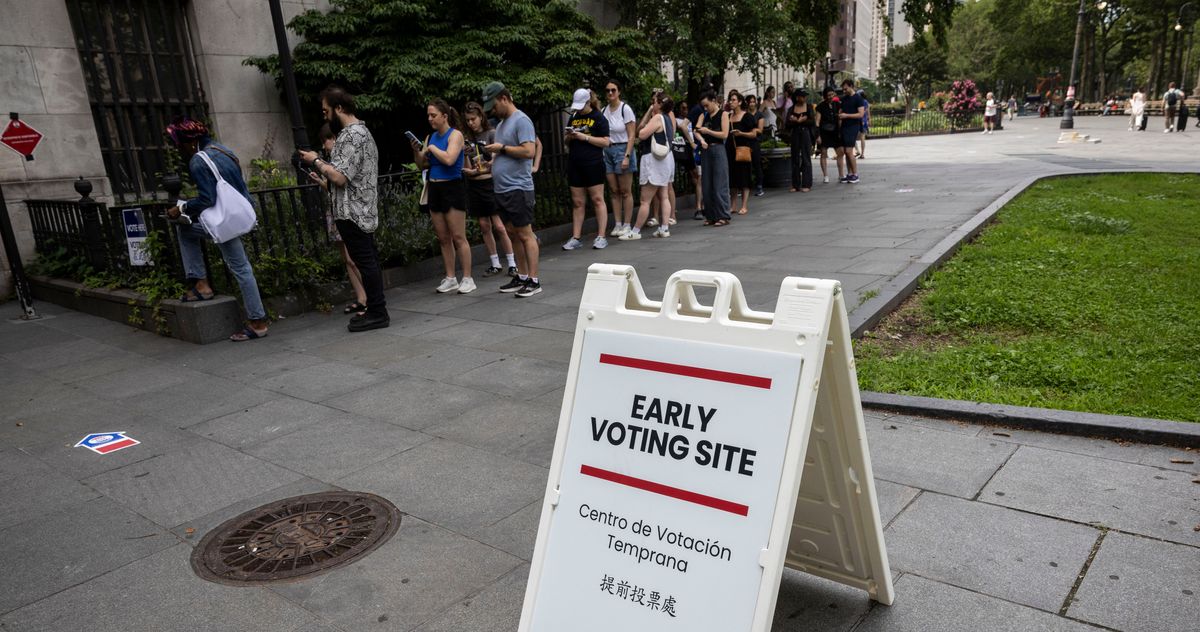
Photo: Christian Monterrosa/Bloomberg/Getty Images
The upcoming vote for mayor and other municipal offices is the main event on Election Day, but New Yorkers will also weigh in on a ballot question that, if approved, would start the process of revising the City Charter and the State Constitution to move city elections from the current odd-numbered-year schedule and make them coincide with the year we pick presidential candidates. If that happens, we’ll be joining cities like Baltimore and Los Angeles that recently changed their calendars.
Lots of well-intentioned political leaders, including Governor Kathy Hochul, think it’s a great idea. I don’t.
“There’s not the voter participation that we should have in a country like the United States of America,” Hochul told me recently. “It is a privilege to vote, people shed blood for this right, it was denied to people of color for so many decades — for a hundred years — and people won that right. I want more people to exercise. And what happens is in a non-presidential election, non-governor’s election year, there’s not as much attention.”
No argument there; the numbers show that lots more New Yorkers come out to vote for president than for mayor or any other local office. Last year, according to city figures, just over 60 percent of the city’s 4.7 million active registered voters turned out in the race between Donald Trump and Kamala Harris. That’s not far behind the national average of around 64 percent, and much higher than the 23 percent who voted in the 2021 general election for New York City offices.
Overall, turnout in city elections has been trending downward for decades. Just over 32 percent of voters came out in 2001, and that number dropped in 2005 and 2009, reaching an all-time low of only 20 percent of registered voters casting ballots in the 2013 election, with slight upticks in 2017 and 2021. New York’s quarter-century of steadily declining participation is what worries Hochul.
“We wish everybody would participate all four years, but they don’t, so let’s acknowledge human nature,” she told me. “I also think there’s something that goes on — it’s election fatigue. People need a break; otherwise, it’s nonstop campaigning all year round for four straight years. And I think when you sometimes have special elections, and vacancies, and the mayor — we have school-board races at different times — it’s very confusing to people. So let’s just simplify it and have one big election.”
The main problem with “one big election” is that national political dynamics would inevitably cause vital city issues unique to New York to get swallowed, distorted, or ignored. Take the issue of congestion pricing: After more than a decade of study, struggle, and the creation of an unlikely alliance among environmentalists, transportation advocates, and big businesses, Manhattan below 60th Street is currently the only place in America with a general toll on vehicles. It’s safe to assume that most voters in car-dominant swing states like Georgia, Arizona, Wisconsin, and Michigan don’t understand or care about New York’s innovative experiment — and might decide to attack it, as Trump vowed to do before the election (and, thankfully, has thus far been blocked from doing by a federal court). New York is better off deciding local issues without a lot of political noise coming from — or intended for — other places.
And imagine trying to help voters focus on strictly local matters — like when to close Rikers Island, how to fund public housing, or whether to boost money for our parks — while national candidates are spending hundreds of millions of dollars flooding the airwaves with ads for and against sweeping issues like the 900-page Project 2025 agenda. The last thing we need is local candidates bloviating about funding Social Security or supporting NATO instead of telling us how they plan to improve trash pickups, improve the schools, or hire more social workers to help the homeless.
This is not a hypothetical concern. Back in 1894, reformers changed the State Constitution to hold city elections in a so-called “off year” specifically so that decisions would be made by people concerned about local issues without the distraction of national issues like war and peace. More than a century later, for some reason, today’s reformers see that intentional narrowing of focus as a bad thing.
“I think New Yorkers can walk and chew gum at the same time,” says Richard Buery, who chaired the Charter Revision Commission supporting a change in the election calendar. “Right now, in the middle of this mayoral election, it’s not like people aren’t talking and dealing with the issues at the federal level and national level,” he told me. “I think people can figure out what matters.”
I’m not so sure about that. Year after year, researchers and pollsters find that most Americans don’t know who represents them in Congress and can’t name the three branches of government. A University of Pennsylvania survey recently found that “over half of Americans (51 percent) continue to assert incorrectly that Facebook is required to let all Americans express themselves freely on its platform under the First Amendment.” It’s hard enough trying to inform the public about hyperlocal issues like neighborhood rezonings or installing bike lanes; trying to simultaneously discuss farm subsidies, funding for health research, and other issues would be all but impossible.
If New York is going to be hell-bent on increasing participation, we should be at least a little bit concerned about making sure it’s informed participation.
Beyond the policy questions, New York’s local political scene can only benefit from keeping some distance and difference from the national parties. One reason Republicans in New York have been pushed to the edge of extinction over the last decade — no GOP candidate has won a statewide office since 2002 — is that voters associate them with a national party that has become stridently conservative and wholly subservient to President Trump. Curtis Sliwa, the current Republican candidate for mayor, told me he can’t win without getting support from disaffected Democrats — and that his already uphill battle for City Hall would become almost impossible if Trump endorsed him or otherwise got involved in the race.
On the other side of the aisle, city Democrats skew significantly more to the left than the national party — witness the rise of Alexandria Ocasio-Cortez and Zohran Mamdani — and it’s not clear that older, centrist national Democrats, who rallied around Joe Biden even after it was clear that he should retire, have the energy to lead, absorb, or suppress the youth-powered political movement surging through New York. Which is one more reason we should make sure city elections remain by and for New Yorkers only.
Sign Up for the Intelligencer Newsletter
Daily news about the politics, business, and technology shaping our world.
Vox Media, LLC Terms and Privacy Notice
